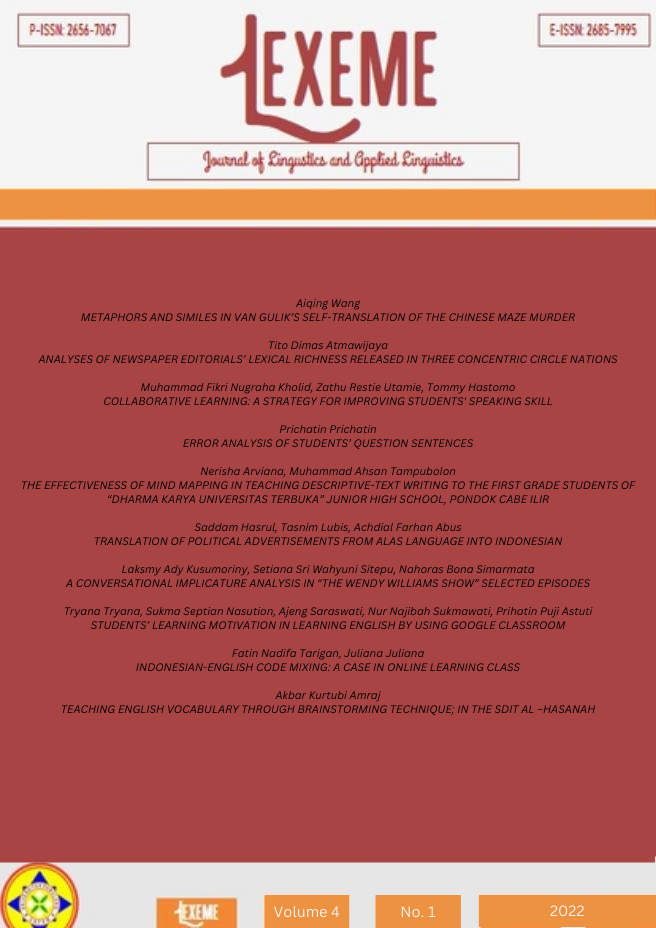COLLABORATIVE LEARNING: A STRATEGY FOR IMPROVING STUDENTS' SPEAKING SKILL
DOI:
https://doi.org/10.32493/ljlal.v4i1.19064Keywords:
Collaborative, learning, teaching, speakingAbstract
This research aimed to identify the collaborative English learning at UIN Raden Intan Lampung. Classroom Action Research is the research method in this study. The researchers employed the theory from Harmer (2007) and Dillenbourg (1999) as the fundamental theory in this research. Collaborative learning is an effective strategy for teaching Sharia Economics students at UIN Raden Intan Lampung. There are five stages in this action research: diagnosing, planning, action, observation, and reflection. The findings show that collaborative learning can improve students' speaking ability because this strategy can increase their engagement, confidence, and critical thinking to deliver their ideas in classroom activities.
References
Brown, H. D. (2004). Language Assessment: Principles and Classroom Practices. New York: Pearson Education.
Burns, A. (1999). Collaborative Action Research for English Language Teachers. New York: Cambridge University Press.
Burton. S. H. (1982). Mastering English Language. London: The McMillian Press Ltd.
Collazos, C. A., Guerrero, L.A,.Pino, J. A., & Ochoa, S. F. (2002). Evaluating Collaborative Learning Processes. In J.M. Haake& J.A. Pino (Eds.), Department of Computer Science (pp. 203–221).Springer-Verlag Berlin Heidelberg.
Cross, K. P., & Angelo, T. A. (1993). Classroom assessment. Techniques: A Handbook for Fac.
Dillenbourg, P. (1999). What do you mean by collaborative learning?. In P. Dillenbourg (Ed) Collaborative-learning: Cognitive and Computational Approaches.
Efrizal, D. (2012). Improving Students’ Speaking through Communicative Language Teaching Method at Mts Ja-alhaq, Sentot Ali Basa Islamic Boarding School of Bengkulu, Indonesia: International Journal of Humanities and Social Science. 2(20).[Special Issue – October 2012].
Harmer, J. (2007). How to Teach English. London: Pearson Education Limited.
Louma, S. (2004). Assessing Speaking. England: Cambridge University Press.
Madya, S. 2009. Teori dan Praktik Penelitian Tindakan. Bandung: Alfabeta.
Nasution, S. S., & Sukmawati, N. N. (2019). Model United Nations: Improving the students' speaking skill. JEES (Journal of English Educators Society), 4(2), 47-52.
Nasution, S. S., Sukmawati, N. N., Lubis, A. A., Hastomo, T., & Sesriyani, L. (2020). Using critical discourse analysis to explore an authentic teaching material: A focus on language and power. Studies in English Language and Education, 7(2), 527-543.
Nunan, D. (1989). Designing tasks for the communicative classroom. Cambridge university press.
Nurhayati, S. (2011). Teaching Speaking Skill Through Communicative Language Teachinng. Jakarta: UIN Jakarta.
Pollard, L. (2008). Guide to Teaching English. (UnpubliHed doctoral dissertation).
Wulandari, R. (2014). Improving students’ speaking ability through communicative language games at SMPN 1 Prambanan grade VIII A in the academic year of 2013/2014 (Doctoral dissertation). Indonesia: Universitas Negeri Yogyakarta.
University Teaching Service. (1997). Collaborative Learning Activities. Winnipeg: The University of Manitoba.







